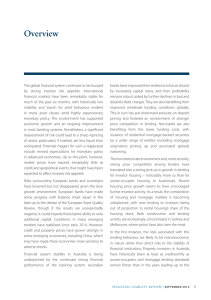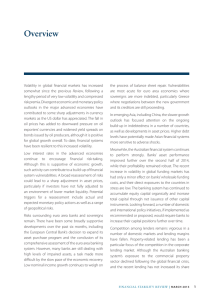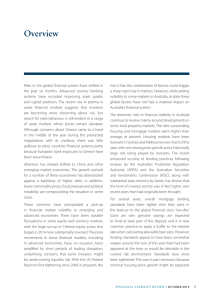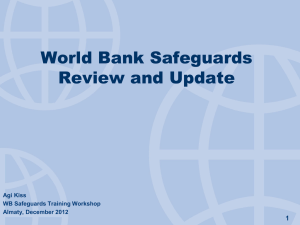Overview
advertisement
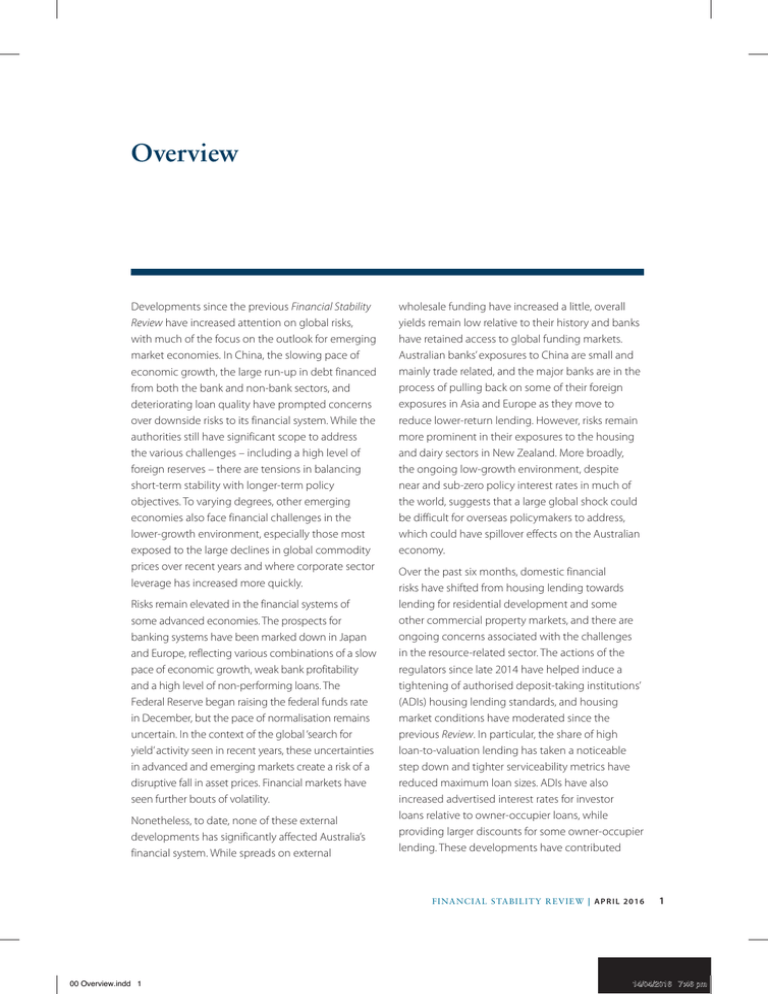
Overview Developments since the previous Financial Stability Review have increased attention on global risks, with much of the focus on the outlook for emerging market economies. In China, the slowing pace of economic growth, the large run-up in debt financed from both the bank and non-bank sectors, and deteriorating loan quality have prompted concerns over downside risks to its financial system. While the authorities still have significant scope to address the various challenges – including a high level of foreign reserves – there are tensions in balancing short-term stability with longer-term policy objectives. To varying degrees, other emerging economies also face financial challenges in the lower-growth environment, especially those most exposed to the large declines in global commodity prices over recent years and where corporate sector leverage has increased more quickly. Risks remain elevated in the financial systems of some advanced economies. The prospects for banking systems have been marked down in Japan and Europe, reflecting various combinations of a slow pace of economic growth, weak bank profitability and a high level of non-performing loans. The Federal Reserve began raising the federal funds rate in December, but the pace of normalisation remains uncertain. In the context of the global ‘search for yield’ activity seen in recent years, these uncertainties in advanced and emerging markets create a risk of a disruptive fall in asset prices. Financial markets have seen further bouts of volatility. Nonetheless, to date, none of these external developments has significantly affected Australia’s financial system. While spreads on external wholesale funding have increased a little, overall yields remain low relative to their history and banks have retained access to global funding markets. Australian banks’ exposures to China are small and mainly trade related, and the major banks are in the process of pulling back on some of their foreign exposures in Asia and Europe as they move to reduce lower-return lending. However, risks remain more prominent in their exposures to the housing and dairy sectors in New Zealand. More broadly, the ongoing low-growth environment, despite near and sub-zero policy interest rates in much of the world, suggests that a large global shock could be difficult for overseas policymakers to address, which could have spillover effects on the Australian economy. Over the past six months, domestic financial risks have shifted from housing lending towards lending for residential development and some other commercial property markets, and there are ongoing concerns associated with the challenges in the resource-related sector. The actions of the regulators since late 2014 have helped induce a tightening of authorised deposit-taking institutions’ (ADIs) housing lending standards, and housing market conditions have moderated since the previous Review. In particular, the share of high loan-to-valuation lending has taken a noticeable step down and tighter serviceability metrics have reduced maximum loan sizes. ADIs have also increased advertised interest rates for investor loans relative to owner-occupier loans, while providing larger discounts for some owner-occupier lending. These developments have contributed F IN AN C IAL STAB IL ITY R E VIE W | A P R I L 2 0 1 6 00 Overview.indd 1 1 14/04/2016 7:46 pm to a moderation in the pace of investor credit growth, though the effect on growth of overall housing credit has been largely offset by a pick-up in owner-occupier lending. While the household debt-to-income ratio has increased a little further, mortgage buffers in offset and redraw facilities are rising strongly, which helps to mitigate any associated risks. While these developments have generally enhanced resilience in the household sector, the tighter access to credit for households could pose near-term challenges in some medium- and high-density construction markets given the large volume of building activity that was started several years ago. These apartments are popular with investors and foreign buyers and any concerns over settlement risk and/or a slowdown in demand for Australian-located property by Chinese and other Asian residents could lead to difficulties for particular projects, though there is little evidence of either occurring so far. Risks seem greatest in the inner-city areas of Melbourne and Brisbane, where new supply is most geographically concentrated, and increasingly in Perth. Some other commercial property markets are also adjusting with a lag to a slowing in demand. This is most noticeable for office buildings in the resourceintensive states, where vacancy rates remain very high as further supply continues to come on line. More broadly, commercial property yields have compressed across a range of market segments and there are some questions over their sustainability at these levels once global interest rates normalise. In the rest of the business sector, the balance sheets of resource-related companies have come under strain following the large falls in global commodity prices over recent years and interest payments are taking an increasing share of earnings for the smaller producers and mining-related services firms. In contrast, the non-resources business sector shows little sign of financial difficulties. None of these domestic risks appears to be enough on their own to seriously degrade the near-term 2 functioning of the domestic financial system, though they could exacerbate a major shock from elsewhere, such as a global economic downturn. In any case, Australian-based banks have taken further steps to increase their resilience to potential risks. As noted, ADIs have tightened their housing lending standards to align them with the prudential regulator’s expectations. While lending to the commercial property sector by the Australian major and Asian banks has continued to rise, many ADIs have tightened lending standards in this area and have reportedly become quite cautious in lending to certain parts of the sector. Banks’ non-performing loans remain low overall: while they have picked up for resource-related lending, banks’ exposures to this sector and to mining services firms are small. That said, some foreign banks operating in Australia have much higher shares of their total lending to this sector. Bank profitability has also remained high and capital levels have increased substantially in the past year. Nonetheless, with banks now competing intensely for lending in a narrower range of markets, it will be important that their serviceability and other lending standards remain appropriate. Domestic regulators continue to advance a number of policies, partly in response to the parts of the Basel III global capital framework that are expected to be finalised later this year. In recent months, the Australian Prudential Regulation Authority (APRA) announced the specifics of its countercyclical capital buffer policy (set initially at 0 per cent) and released its policy for banks’ medium-term liquidity management for consultation. APRA will announce around the end of the year how an ‘unquestionably strong’ capital framework will be achieved. A range of policies are also being finalised in Australia and abroad that will affect major players within the financial system architecture. While these measures are expected to enhance financial stability over the medium term, it will be important to continue to monitor how they are affecting bank incentives and behaviour, as well as the interaction between banks and the broader financial system, in the period ahead. R R ES ERV E B A N K O F AUS T RA L I A FS Financial Stability Review.indb 2 14/04/2016 4:37 pm

